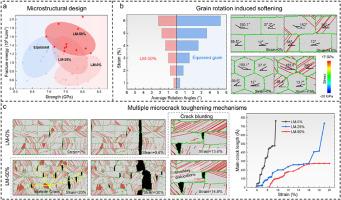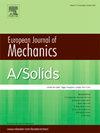纳米层压结构强度-韧性协同作用的机理研究:堆叠构型的作用
IF 4.2
2区 工程技术
Q1 MECHANICS
引用次数: 0
摘要
纳米层合结构以其优异的强韧性协同性能在金属材料设计中得到了广泛的关注。然而,潜在的变形和破坏机制以及结构参数对这些过程的定量影响仍然没有得到充分的了解,这阻碍了纳米层压结构的合理设计和优化。本研究采用大尺度分子动力学(MD)模拟数千万原子,研究了不同重叠比的纳米层合结构在单轴拉伸下的力学响应。与等轴晶粒结构相比,纳米层合结构表现出更高的强度,这主要是由于晶界稳定性的提高。重叠比对强度影响不大,但对断裂伸长率和能量有积极影响。lm - 50%结构(重叠率为50%的纳米层状结构)在强度和韧性之间达到了最好的平衡。这种性能归因于协同机制,包括应力均匀化、裂纹钝化和多个微裂纹的激活,这些机制降低了应力强度因子,促进了穿晶和沿晶交替破坏路径。此外,9R层状断裂结构的出现有助于局部应力释放,抑制裂纹尖端应力集中,提高整体抗断裂能力。这些发现为堆积控制变形提供了原子水平的见解,并为开发高强度、耐损伤的纳米层压材料提供了设计指南。本文章由计算机程序翻译,如有差异,请以英文原文为准。

Mechanistic insights into the strength–toughness synergy of nano-laminated structure: Role of stacking configurations
Nano-laminated structures have gained significant attention in the design of metallic materials due to their excellent strength-toughness synergy. However, the underlying deformation and failure mechanisms—as well as the quantitative influence of structural parameters on these processes—remain insufficiently understood, hindering the rational design and optimization of nano-laminated architectures. In this study, large-scale molecular dynamics (MD) simulations involving tens of millions of atoms were employed to investigate the mechanical response of nano-laminated structures with varying overlap ratios under uniaxial tension. Compared to equiaxed grain structures, the nano-laminated configurations exhibit enhanced strength, primarily due to improved grain boundary stability. While the overlap ratio has little effect on strength, it positively influences fracture elongation and energy. The LM-50 % structure (nano-laminated structure with a 50 % overlap ratio) achieves the best balance between strength and toughness. This performance is attributed to synergistic mechanisms, including stress homogenization, crack blunting, and the activation of multiple microcracks that reduce the stress intensity factor and promote an alternating transgranular and intergranular failure path. Furthermore, the emergence of 9R stacking fault structures contributes to local stress relief and suppresses crack-tip stress concentration, enhancing overall fracture resistance. These findings provide atomistic-level insights into stacking-controlled deformation and offer design guidelines for the development of high-strength, damage-tolerant nano-laminated materials.
求助全文
通过发布文献求助,成功后即可免费获取论文全文。
去求助
来源期刊
CiteScore
7.00
自引率
7.30%
发文量
275
审稿时长
48 days
期刊介绍:
The European Journal of Mechanics endash; A/Solids continues to publish articles in English in all areas of Solid Mechanics from the physical and mathematical basis to materials engineering, technological applications and methods of modern computational mechanics, both pure and applied research.

 求助内容:
求助内容: 应助结果提醒方式:
应助结果提醒方式:


